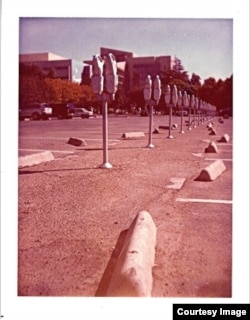When Edwin Land introduced the Polaroid instant camera in 1948, it revolutionized photography. People could take a picture and immediately watch the image appear before their eyes. Today, digital photography has given new meaning to the phrase ‘instant camera,’ and in 2008, Polaroid stopped manufacturing film for its cameras.
However, shortly after Polaroid announced it would stop producing its self-developing film, a group of former employees pooled their resources to continue manufacturing it on a limited scale.
“These folks were told that trying to revive the Polaroid film was impossible. So, they said, ‘OK, we’re going to name it the Impossible Project,'” said Kayce Baker, head of Impossible North America.
She says Polaroid’s instant camera essentially gave photographers a portable darkroom. The film cassette that slipped into the camera contained photographic paper, a negative, a substance to fix the image and another to stop the photo from developing further. Rollers inside the camera exploded the chemical packs after the image was exposed to set off the process.
“Back in the day, when you had to take the little film down to a lab to process it, you had to wait some time," she said. "It got faster and faster down to 30 minutes. But for the most part you still had to wait to get the printed image. Instant photography was just a great sharable type of imaging experience. It’s kind of what people do today with social media; Facebook, Instagram and so on.”
And people can still do it today, with a new generation of instant film cameras. Polaroid got back in the market, and other companies have joined them.
“The idea of taking an image and having it eject as a physical, tangible artifact out of your camera, I found was really intriguing,” said Noe Arteaga, 26, an instant photography fan.
In fact, he says, he prefers physical photos to digital ones.
“Storing your files and data is now becoming completely intangible, completely electronic, like storing your things on the cloud. You no longer need a flash drive or an external hard drive or anything like that," Arteaga said. "But I think because this sort of advance in technology has been moving so rapidly, people are sort of losing all that. People definitely do start shooting with film so that they can have like a physical representation of that.”
Although she works with high-tech digital systems, Heather Champ, who is from San Francisco, has always loved taking photos with her mother’s Polaroid camera because of their authenticity and immediacy.
“That’s the original object and it's unique," Champ said. "So much can happen either with digital or with more traditional film format like 35mm or 120mm film. You don’t know how that image may have been manipulated from the moment it was taken to the moment you’re viewing it. When you’re holding the original instant photograph, that’s it, that’s the photograph. There is kind of no lying about it."
Jessica Reinhardt is a fine art photographer from Los Angeles, California, who received her first Polaroid camera as a gift from her father while she was studying photography in college.
“Digital has become almost too sterile," she said. "It has almost a hyper-realism to it and that can sort of take away from using your imagination when you look at a photograph. I think that's one of the reasons people are turning towards film again because it has the warmth and a unique viewpoint that not even the best Photoshop artist can truly capture.”
She says photographers, whether they are amateurs or professionals, don’t have to choose between digital and film.
“In the photography world, there has always been this sort of antagonistic viewpoint of digital versus film," Reinhardt said. "I think the two can coexist. I think there is room for innovation in both areas. (For example,) there are many artists out there creating digital negatives or digital positive images and rendering that onto analog film.”
Impossible has developed a device called the Instant Lab, which projects a digital photo from a smartphone onto special film and transforms it into a physical photo. Baker says innovations like that will encourage more people to rediscover the art and artistry of film photography.
However, shortly after Polaroid announced it would stop producing its self-developing film, a group of former employees pooled their resources to continue manufacturing it on a limited scale.
“These folks were told that trying to revive the Polaroid film was impossible. So, they said, ‘OK, we’re going to name it the Impossible Project,'” said Kayce Baker, head of Impossible North America.
She says Polaroid’s instant camera essentially gave photographers a portable darkroom. The film cassette that slipped into the camera contained photographic paper, a negative, a substance to fix the image and another to stop the photo from developing further. Rollers inside the camera exploded the chemical packs after the image was exposed to set off the process.
“Back in the day, when you had to take the little film down to a lab to process it, you had to wait some time," she said. "It got faster and faster down to 30 minutes. But for the most part you still had to wait to get the printed image. Instant photography was just a great sharable type of imaging experience. It’s kind of what people do today with social media; Facebook, Instagram and so on.”
And people can still do it today, with a new generation of instant film cameras. Polaroid got back in the market, and other companies have joined them.
“The idea of taking an image and having it eject as a physical, tangible artifact out of your camera, I found was really intriguing,” said Noe Arteaga, 26, an instant photography fan.
In fact, he says, he prefers physical photos to digital ones.
“Storing your files and data is now becoming completely intangible, completely electronic, like storing your things on the cloud. You no longer need a flash drive or an external hard drive or anything like that," Arteaga said. "But I think because this sort of advance in technology has been moving so rapidly, people are sort of losing all that. People definitely do start shooting with film so that they can have like a physical representation of that.”
Although she works with high-tech digital systems, Heather Champ, who is from San Francisco, has always loved taking photos with her mother’s Polaroid camera because of their authenticity and immediacy.
“That’s the original object and it's unique," Champ said. "So much can happen either with digital or with more traditional film format like 35mm or 120mm film. You don’t know how that image may have been manipulated from the moment it was taken to the moment you’re viewing it. When you’re holding the original instant photograph, that’s it, that’s the photograph. There is kind of no lying about it."
Jessica Reinhardt is a fine art photographer from Los Angeles, California, who received her first Polaroid camera as a gift from her father while she was studying photography in college.
“Digital has become almost too sterile," she said. "It has almost a hyper-realism to it and that can sort of take away from using your imagination when you look at a photograph. I think that's one of the reasons people are turning towards film again because it has the warmth and a unique viewpoint that not even the best Photoshop artist can truly capture.”
She says photographers, whether they are amateurs or professionals, don’t have to choose between digital and film.
“In the photography world, there has always been this sort of antagonistic viewpoint of digital versus film," Reinhardt said. "I think the two can coexist. I think there is room for innovation in both areas. (For example,) there are many artists out there creating digital negatives or digital positive images and rendering that onto analog film.”
Impossible has developed a device called the Instant Lab, which projects a digital photo from a smartphone onto special film and transforms it into a physical photo. Baker says innovations like that will encourage more people to rediscover the art and artistry of film photography.











